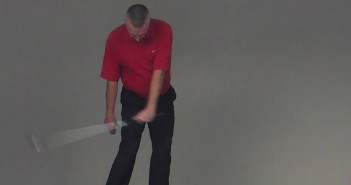In this drill you will start to feel, perhaps for the very first time since you started playing this great game, what generating club head speed actually feels like in a tour professional’s golf swing.
With Golf Swing Drill 504a and Golf Swing Drill 504b, you’ve learned how to release the golf club properly with your left hand, and how you can generate quite a lot of club head speed, with a very small swing, by relying only on gravity.
You’ve started to discover the compound pendulum.
In this drill, you’ll start to learn how you can supplement the compound pendulum effect, adding much more speed with very little effort, with the careful use of your right hand.
As always, apologies to the lefties out there, but for simplicity this article will describe movements for the right-handed golfer.
This is the forth in a series of drills that breaks down and isolates the movements in the proper release of the golf club.
In this drill, we are isolating the sensation of injecting speed into the release using the right hand.
This drill builds on the movements you have been working on in Golf Swing Drill 504a – Downswing: The Left Hand Release Movement and Golf Swing Drill 504b – Downswing: The Left Hand Golf Club Release.
If you haven’t yet become proficient with the movements in Golf Swing Drill 504a and Golf Swing Drill 504b, it is very important that you spend some time working on them before attempting this drill.
It’s natural to want to progress through the drills as quickly as possible, but if you haven’t first started to ingrain the basic movement patterns, then your impatience will hinder the improvements to your golf swing.
For more information on how this learning process works, see How to Learn a Great Golf Swing.
Note: we strongly recommend that, at first, you don’t work on this drill in the same sessions that you practise Golf Swing Drill 504c – Downswing: Ground Reaction Force in the Release. Both drills should be practised in conjunction with Golf Swing Drill 504a and Golf Swing Drill 504b, but not together with each other until you are proficient with both. To learn most effectively, you need to be very sensitive to the feelings created by each of these drills separately, to isolate them, and trying to learn them together will hinder your progress at first.
For a better understanding of what this drill is trying to achieve, and why these movements work, please see Golf Swing 504 – Downswing: How to Release the Golf Club, Golf Lag and the Compound Pendulum, and The Role of the Right Arm in the Golf Downswing.
Feel the Speed!
Why is the concept of “effortless speed” so important? Because it means you are swinging the golf club efficiently, getting more distance while swinging in balance, with more control and consistency.
You are swinging in harmony with nature’s compound pendulum, not fighting it. Once you can do this, then your ball striking will improve dramatically, and your scores will drop like a stone.
Once proficient with this drill, with just a simple, tiny swing – only applying force through the middle fingers of your right hand, with no turn – most students can swing an 8-iron at speeds in excess of 50mph (80kph) through impact, some higher than 60mph (96kph).
To put that into perspective, the PGA Tour average for an 8-iron with a full swing is 87mph, or 140kph (on the LPGA Tour it’s 74mph, 120kph).
So that’s up to 70% of Tour average with just a small swing and your fingertips – which is more than many amateurs can achieve flat out!
We’re not suggesting that you play golf with a swing like this, it’s not yet stable enough to be consistent, and there are more sources of power that we will tap into with the full swing, but it demonstrates how moving correctly will generate much more club head speed, and with very little effort.
The Drill
Remember that this is a drill, we’re isolating certain movements – the real golf swing will be different since it incorporates a number of other movements, but the feelings and movement patterns that you are ingraining here will quickly improve your golf swing…

or Log In
…through impact and past your hand as your wrist rotates.
If you have any questions or comments about this or other articles on Golf Loopy, please send us an email.
Next up: we’ll work on the correct movement of the right hand in the release, building speed and stability, and helping to square the club face perfectly every time, in Golf Swing Drill 504e – Downswing: The Right Hand Release Movement – the Spider-Man Drill.




